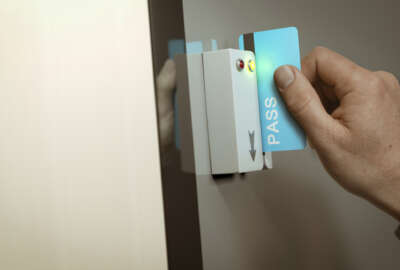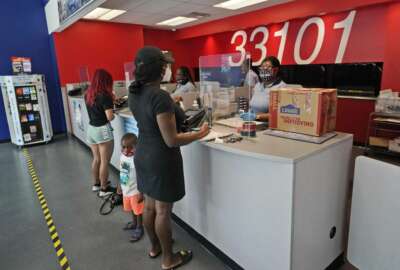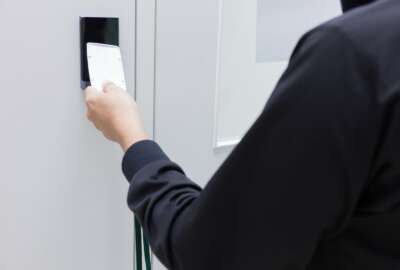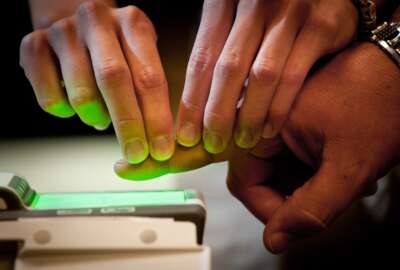
USPS, GSA expand ‘government storefront’ concept with PIV card pilot
The General Services Administration and the U.S. Postal Service made it easier for new employees or current ones to get a new identity card during the pandemic.
Agencies shut down nearly 500 credentialing offices during the COVID-19 pandemic, making it harder for federal employees and contractors to update their Personal Identity Verification (PIV) cards.
To fill in those gaps in service, the Postal Service and General Services Administration stood up USAccess credentialing sites at seven D.C.-area post offices, as part of an ongoing pilot.
At least 5,000 federal employees have obtained new or updated credentials from post offices during the initial stages of the pilot, which will run through May, and is part of the Postal Service’s broader vision of being a storefront for government services.
Jeff Tackes, the Postal Service’s acting director of digital business, said about 90% of the U.S. population lives within 10 miles of the nearest one of 4,000 post offices that offer passport services.
About 17,000 post offices have the kind of retail terminals that could eventually provide identity-proofing services. At that point, Tackes said those services would be available to a percentage of the population in the high-90s.
The USPS is also expanding its biometric capabilities to 4,000 post offices and works with the FBI to provide “rap sheets” to customers applying for visas, adopting a child or applying for jobs working with children. USPS also uses its biometrics capabilities to vet the 120,000 employees it hires annually.
OMB played matchmaker
Tackes said the concept for the pilot took hold soon after USPS gave a presentation at a GSA identity summit last November, giving an overview of the agency’s growing biometrics program.
“It just made sense that with all these outlets, we saw down the road that this would be a really good fit for a more convenient, more accessible way for federal employees and contractors to be able to get onboarded more easily,” Tackes said.
Darlene Gore, the director for identity credential and access management at the Office of the IT Category in the Federal Acquisition Service at GSA, said the Office of Management and Budget brought the two organizations together soon after the pandemic started.
She said GSA and OMB were looking for different approaches to continue to provide identity and credentialing services. Due to COVID-19 safety measures, agencies with USAccess offices onsite limited who could use the service, while other sites had to close down entirely. OMB and GSA were trying to fill in the gaps caused by the pandemic.
“It was ideal because it would never be interrupted. They’re already doing business with the State Department on passports. So expanding that service to identity credential services was almost like a win-win situation, especially since it would mean that we could continue the services,” Gore said.
Planning for the pilot started in March and it launched in November.
GSA provides USAccess equipment to post offices included in the pilot, manages customer appointments through an online scheduling tool and trains USPS employees.
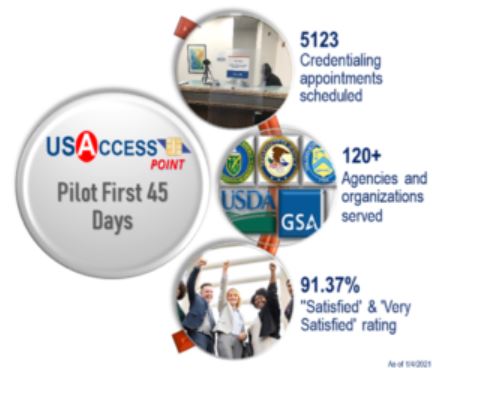
USPS identified the post offices best suited for the pilot, but Tackes said USPS expects eventually to take on more aspects of the pilot.
“In later phases, we’re envisioning a mix or completely doing this on Postal Service infrastructure, with GSA, of course, still being the part that connects all the agencies to the process to be able to get these services completed,” Tackes said.
Agencies closed several hundred USAccess sites during the pandemic, which puts a strain on the capacity of sites that remain open.
While agencies have established some temporary workarounds to onboard new employees virtually, some federal employees have had to schedule appointments at the nearest available facility, which at this point may be an hour or more away.
Early success leads to expansion
Post offices in the pilot not only provide easier access during the workweek, but some even offer these services over the weekend.
“The Postal Service is critical infrastructure. We stay open,” Tackes said. “We’ve done a really good job of protecting our employees, making sure they have the processes in place to make sure these transactions are safe.”
In the first 90 days of the pilot, which started late last year, USPS and GSA processed about 4,500 credentials from employees from 120 agencies.
“The applicant or the individual is just able to go to the Post Office to conduct what we call the enrollment process. That means taking your fingerprint, taking your pictures, identity proofing to make sure the individual is the person that the card is being issued to,” GSA’s Gore said. “There’s no changes to the process. It is just where the service is, and where the customers can go to get that service. It made it easier for the customer. ”
Based on this early success, both agencies will keep the pilot running for another 90 days. Tackes said customers have given positive feedback on the pilot, and that appointments fill up incredibly fast once GSA posts new availabilities.
USPS conducted the first phase of the pilot through Election Day — when it processed a historic volume of mail-in ballots — and its peak holiday season —when the agency delivered a record-breaking 1.1 billion packages.
“We were able to understand from the pilot that will be able to service these transactions in a way that’s really highly satisfying for the participants, at the same time that we have a lot of operational activity going on throughout the rest of the Postal Service,” Tackes said. “It was really comforting for us to see the positive feedback, even during a time when we were really stretched as an organization, to be able to provide the other services around the election period and then around the holiday peak season.”
Gore added these next 90 days will help GSA and USPS capture any lessons learned and data needed to ensure expansions are successful.
“If we’re going to expand, where would that location be? Where are those underserved locations, so we just want to just kind of pinpoint some of those pain points of the customers, and then try to meet some of those needs, as we try to phase in different expansions for a partnership,” she said.
95% approval rating
Gore added that federal employee customer response surveys have been positive, which is partly why the agencies extended the pilot.
“During the first 90 days, we had a 95% approval satisfaction. We think that’s outstanding. The second thing that we thought about for this pilot is efficiency through consistency. So the Postal Service offered us a consistent way of processing PIV cards,” she said. “Normally it takes around 17 minutes to process and enroll a federal employee. Because the Postal Services has the same clerks, they’re really focused on making sure that customer experience is good so they have decreased that time down to like 14 minutes. And so to me, that spells efficiency.”
The next steps for the pilot include extending this “government storefront” concept to more rural and remote parts of the country.
“We’re, of course, starting with those areas where we can service most of the population and at a very close location. Those locations are set up very well for these types of transactions. But we’re also looking at how can we have the infrastructure in place that allows a mobile-type transaction that would be able to move more easily to some of the other sites that may not be positioned as what we call a full-service site or passport site,” Tackes said.
Copyright © 2024 Federal News Network. All rights reserved. This website is not intended for users located within the European Economic Area.
Jason Miller is executive editor of Federal News Network and directs news coverage on the people, policy and programs of the federal government.
Follow @jmillerWFED
Jory Heckman is a reporter at Federal News Network covering U.S. Postal Service, IRS, big data and technology issues.
Follow @jheckmanWFED
Related Stories
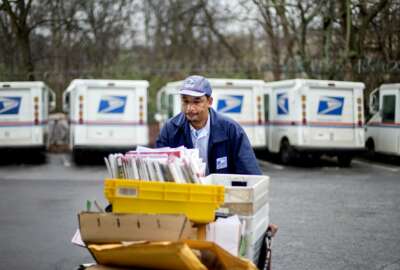
USPS 5-year business plan: ‘Innovate faster,’ cut costs to remain solvent
